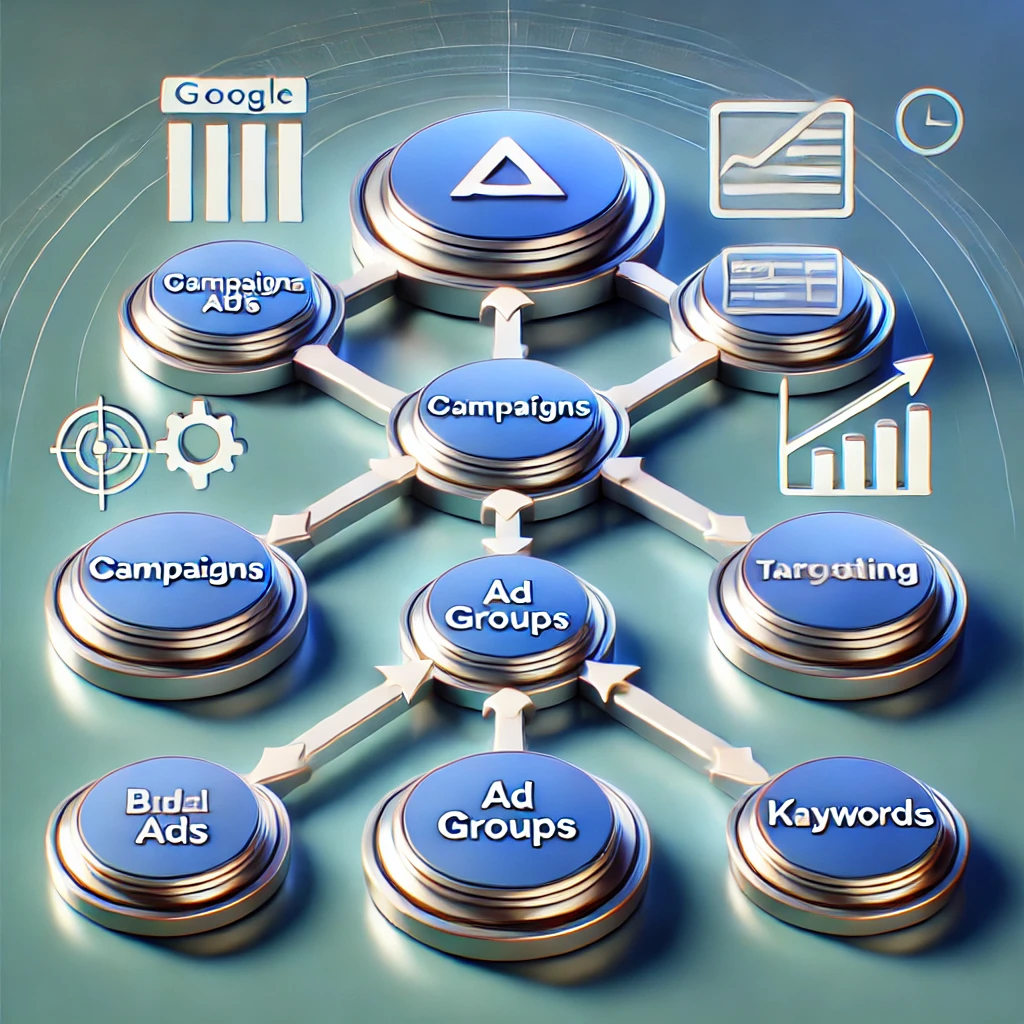When you first start using Google Ads, the platform may seem complex, with its many different features and settings. But once you understand its structure, it becomes a powerful tool for driving targeted traffic, increasing sales, and reaching your business objectives. The key to success with Google Ads lies in how you organize and structure your campaigns, ad groups, and ads.
What is Google Ads?
Google Ads (formerly Google AdWords) is Google’s paid advertising platform, allowing businesses to create ads that appear in Google search results and across the Google Display Network. Google Ads operates on a pay-per-click (PPC) model, meaning you only pay when someone clicks on your ad. It also offers various targeting options to ensure your ads are shown to the right people.
But to achieve success with Google Ads, it’s essential to understand its underlying structure. Google Ads is organized into three levels:
- Campaigns
- Ad Groups
- Ads
Each level plays a unique role in ensuring that your ads are effective, efficient, and relevant to the people you’re targeting.
1. What is a Google Ads Campaign?
A campaign is the highest level of organization within Google Ads. It is where you define your overall advertising strategy, objectives, and budget. Campaigns are where you determine the type of ads you want to run and the broad settings that apply to all the ads within the campaign.
Campaign Settings
Campaign settings are vital in determining the reach and performance of your ads. Here are the key components of campaign settings:
- Campaign Type: This is where you define the objective and format of your campaign. The main campaign types in Google Ads are:
- Search Campaigns: These ads appear in Google’s search engine results when users search for specific keywords related to your business.
- Display Campaigns: These ads appear on websites within the Google Display Network (GDN), which includes millions of sites across the internet. Display ads are usually banners or images.
- Video Campaigns: Ads that appear before or during videos on YouTube and Google’s partner video sites. This is ideal for promoting brand awareness through engaging content.
- Shopping Campaigns: Ads specifically for e-commerce businesses that showcase your products in Google Search and Google Shopping.
- App Campaigns: These are designed to promote mobile app installations by showing ads on various Google networks like Search, Play Store, YouTube, and more.
- Smart Campaigns: These are automated campaigns that simplify ad creation and management, perfect for beginners who are new to Google Ads.
- Campaign Goal: Google Ads allows you to set specific goals for each campaign. These include:
- Sales: If your goal is to increase online purchases.
- Leads: If you’re focusing on capturing form submissions, phone calls, or sign-ups.
- Website Traffic: If your main goal is to drive more visitors to your website.
- Brand Awareness: If your goal is to increase brand visibility.
- Budget: The budget is a fundamental part of any campaign. It defines how much you’re willing to spend per day or for the total lifetime of the campaign. Google Ads uses an auction system to determine how often and where your ad will show based on your budget and bid.
- Targeting: You can target your ads based on several factors, including:
- Geographical location: You can specify cities, countries, or even a radius around your business location.
- Devices: You can target users on desktop computers, tablets, or mobile devices.
- Language: You can target users who speak specific languages.
- Demographics: Age, gender, and parental status are just some of the demographic options you can use to further refine your targeting.
Why Are Campaigns Important?
Campaigns set the tone for everything else in Google Ads. They define your advertising goals and objectives. Once a campaign is set up, everything that falls under it (such as ad groups and ads) will operate according to the settings you’ve defined.
2. What is an Ad Group in Google Ads?
An ad group is the second level of the Google Ads hierarchy. It allows you to organize your ads based on common themes. You can have multiple ad groups under a single campaign, and each ad group focuses on a specific aspect of the products or services you’re promoting.
Ad Group Settings
Ad groups let you organize your ads by grouping them around a set of closely related keywords. Every ad group within a campaign should focus on a specific set of keywords that match the intent of the searcher. Each ad group will contain:
- Keywords: The search terms that trigger your ads. These should be closely related to the products, services, or information you’re promoting.
- Ads: The individual ads you want to show for those keywords. The ads in an ad group should have similar messaging and be relevant to the keywords.
Best Practices for Organizing Ad Groups
- Tightly Grouped Keywords: Ensure that the keywords within an ad group are closely related to one another. For example, in an e-commerce campaign for fitness equipment, create separate ad groups for each product type (e.g., one ad group for dumbbells, another for resistance bands).
- Avoid Keyword Cannibalization: If you use the same keywords across multiple ad groups, you risk competing with your own ads. This can negatively impact your ad performance and budget.
- Ad Copy Relevance: The ad copy should directly match the keywords within the ad group. For example, if someone searches for “buy dumbbells,” the ad should feature the phrase “Buy Dumbbells” in the headline or description. This relevance improves the Quality Score (which we’ll discuss later), leading to better ad placement and lower costs.
Ad Group Example:
For a fitness equipment campaign, you might have the following ad groups:
- Ad Group 1: Dumbbells
- Keywords: “buy dumbbells,” “best dumbbells for home gym,” “affordable dumbbells”
- Ad Copy: “Shop Dumbbells for Home Gym | Free Shipping Available”
- Ad Group 2: Resistance Bands
- Keywords: “buy resistance bands,” “exercise bands for beginners”
- Ad Copy: “Get Resistance Bands for Home Workouts | Shop Now”
Each ad group should focus on a specific product or category, ensuring that users see ads that are directly relevant to their search.
3. What are Ads in Google Ads?
At the ad level, you create the actual advertisements that users will see. Google Ads allows you to run several types of ads, depending on the campaign and ad group type.
Types of Ads
- Text Ads: These are the most common type of ad in Google Search campaigns. Text ads appear in the search results and consist of:
- Headline: A clickable title that describes the product or service.
- Description: A short sentence explaining why the user should click the ad.
- Display URL: A URL that appears in the ad to let users know where they will land.
- Final URL: The URL of the page the user will visit once they click the ad.
- Responsive Search Ads: A newer ad type where Google automatically tests different combinations of headlines and descriptions to show the most relevant combinations for each user.
- Display Ads: These are visually rich ads that show on Google’s Display Network. Display ads can be images, banners, or even video ads.
- Shopping Ads: These ads are used by e-commerce businesses to show products directly in search results or on Google Shopping.
- Video Ads: Ads shown before, during, or after YouTube videos.
Key Components of Text Ads
- Headlines: Headlines are the most important part of your text ad. You can create up to three headlines, with each one up to 30 characters long. Make sure to include your target keywords here for higher relevance.
- Description: You have up to two description lines (90 characters each) to tell the user why they should click on your ad. Make your descriptions action-oriented and include strong calls to action like “Shop Now,” “Free Shipping,” or “Limited Time Offer.”
- Display URL: This is the URL that will be shown to users, although it may not necessarily be the final destination URL. Ensure that the display URL is short, relevant, and easy to understand.
- Final URL: This is the actual destination URL where the user will land after clicking the ad. Make sure that your landing page matches the ad’s promise.
Best Practices for Writing Effective Ads
- Use Keywords in Headlines: Incorporate your targeted keywords into the headlines and descriptions. This helps with ad relevance and Quality Score.
- Clear Calls to Action: Encourage users to take action by including clear and compelling calls to action (e.g., “Shop Today,” “Get Started Now”).
- A/B Testing: Regularly test different versions of your ads (headlines, descriptions, etc.) to find the best-performing combinations.
4. Google Ads Auction System
Google Ads operates on an auction system to determine which ads show up in search results. When a user searches for something, Google runs an auction to select which ads will be shown based on various factors, including the bid, quality score, and ad relevance.
Quality Score
The Quality Score is a key factor in determining the success of your Google Ads campaigns. It is a measure of the quality and relevance of your keywords, ads, and landing pages. A higher Quality Score can help you achieve better ad positions and lower costs.
Conclusion
Understanding the Google Ads structure—campaigns, ad groups, and ads—is crucial for running successful paid search campaigns. Properly organizing your Google Ads account ensures that you target the right audience, structure your budget effectively, and create ads that drive results. By using these foundational concepts, you’ll be on your way to building a well-optimized and cost-effective Google Ads strategy.



